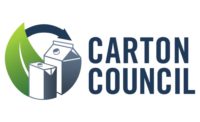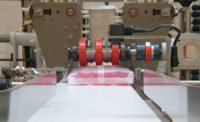Materials
When Recyclability Isn’t Enough
Making sense of more sustainable paper packaging options.




The term “recyclable” has long been a buzzword in the food packaging industry. But now consumers and other stakeholders are demanding more than the iconic three-arrow triangle stamped on their hamburger box. They want renewability. They want safety. And all without sacrificing the functionality of less eco-friendly packaging.
Many types of food packaging have traditionally been formulated with perfluoroalkyl and polyfluoroalkyl substances or PFAS — a group of man-made chemicals used to coat paper or cardboard for fast-food packaging, so it doesn’t fall apart and spill out hot, greasy foods. For decades, brands have relied on PFAS for their functionality and processability.
However, more research over the years has shown that PFAS materials don’t break down naturally in the environment, earning them the name “forever chemicals.” What’s more, scientists and regulatory groups have expressed concerns that PFAS could be linked to cancer, obesity, immunotoxicity and other health problems. Legislative action — as well as litigation — are also adding pressure, particularly in the European market as well as several states in the U.S.
This uncertainty about safety, plus the inability to break down in the environment, has placed more focus on renewable paper materials to replace those derived from fossil fuels. Addressing this need, new options in fiber-based formulations allow the end-use package to be repulped to produce new paper and paperboard products versus fiber-based packaging with barrier films that are typically for single use.
Common Types of PFAS-Free Technology
Some companies, like Solenis, have developed new types of food and beverage packaging paper formulas that deliver PFAS-free solutions. These include the following:
Barrier Coatings: These formulations can be applied to the paper surface and include a range of products that repel water and water vapor, hot and cold liquids, and oils and greases. Ideal for applications like cupstock, gable-top cartons or food wraps, barrier coatings are available as either water-based polymer emulsions or solid biowaxes. Most importantly, paper and board with these barrier coatings are typically repulpable, recyclable and compostable, thereby offering brand owners a way to improve their sustainability credentials with retailers and consumers.
Molded Fiber: Molded fiber solutions build the barrier protection directly into the packaging versus coating the outside, ensuring uniform protection against grease, oil and water. For example, a solution has been developed that’s applied during the wet-end process where non-PFAS-based chemicals are added into the paper pulp. This alternative to PFAS is appropriate for three-dimensional packaging applications, like single-serve bowls, plates and clamshell-type containers for takeout.
Key Considerations for More Sustainable Formulations
As brand owners consider moving toward more environmentally friendly packaging, it’s important to review several key factors in the process.
Compatibility with Existing Production Equipment: Packaging manufacturers invest significant capital into equipment, so any discussion about incorporating a new barrier coating or molded fiber solution must address the production process itself for overall cost feasibility and functionality. For example, a PFAS-free, molded fiber chemical solution can typically be used with existing, installed equipment, so it eliminates the cost and time associated with new equipment or machine modifications.
For packaging that starts as flat paper, barrier coatings can often be applied using typical paper machine coaters, off-machine coaters and printing presses. For example, a biowax-based barrier coating can be applied during the converting process using existing wax applicators.
End-Use Applications: In the molded fiber industry, it’s typical to assess the functionality of fluorine-chemical packaging using tests that involve high-temperature oil. Realistic end-use evaluation, such as test kitchen evaluations or nonstandard testing can help brand owners assess functionality in PFAS-free molded fiber products more accurately. For example, a molded fiber bowl made with PFAS might be specified for protection against oil heated to 100°C. However, during actual use, the packaging may only encounter a maximum temperature that is much lower. By accurately evaluating the functionality requirements to better match the end use, brand owners can choose an appropriate, renewable formula to replace PFAS and still meet the given specifications.
Supply Chain Capabilities: Brand owners should also consider supply chain availability and reliability. Ensuring an interruption-free supply chain starts with checking that any formulation provider can fully service the brand, particularly global ones. This consideration goes beyond logistics; brand owners must also ensure that each provider in the supply chain works together to evaluate and validate potential solutions.
Technical Expertise: Each brand owner has its own unique packaging that encompasses any number of attributes, from appearance to functionality. To check off all the boxes satisfying each stakeholder — whether looking at cost comparability or end-use functionality — it’s essential to partner with a knowledgeable packaging formulation provider that understands the chemistries and how they interact with a given substrate. The right provider can also customize solutions for factors like viscosity, types of solids or drying capabilities. It is also important to work with a partner familiar with different types of equipment, like molded pulp, printing and converting machinery. This allows an improved eco-friendly barrier coating to be optimized for specific equipment for less downtime and maintenance. In addition, expert material suppliers can quickly bring brand owners and anyone else in the value chain up to speed to ensure the right renewable formula for the given application.
PFAS-free food packaging formulas can provide the sustainability and safety benefits all stakeholders want — and demand — in food packaging. By working closely with an experienced formulation solution provider early in the process, brand owners can offer eco-friendly packaging that meets their sustainability goals.
Looking for a reprint of this article?
From high-res PDFs to custom plaques, order your copy today!








